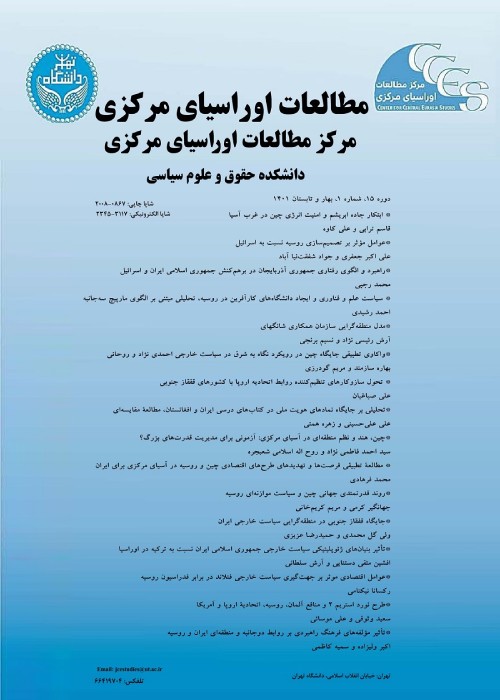Assessment of China’s Strategy in South Caucasus
Author(s):
Article Type:
Research/Original Article (دارای رتبه معتبر)
Abstract:
China as a rising power tries to boost its position in different regions of the world including Central Asia and the South Caucasus. China has made a grand entry into Central Asia and has a growing presence in the South Caucasus region since 2013 by introducing a comprehensive vision of economic development with its Belt and Road initiative (BRI). This article provides a comprehensive insight into China’s strategy in South Caucasus. In recent years, researchers have become increasingly interested in China’s regional policy. Most of them believe that the essence of China’s “New Regionalism” is its desire for a multipolar world based on the principles of non-interference policy and the formation of supranational and transnational integration groupings to strengthen their economic potentials. China’s attitude to South Caucasus follows the fundamental principle which was mentioned above but“each region has its own unique characteristics” that cause it to become a point of special consideration. For example, South Caucasus is a traditional sphere of Russian influence. So, any changes in the balance of power and political-security developments in the region will have implications for Russia. Therefore, cooperation between the South Countries and regional organizations (i.e. EU and NATO) and trans-regional powers (i.e. USA) will cause Russian reactions. This while South Caucasus countries try to diversify their bilateral and multilateral relations to reduce economic and political dependency on Moscow. Despite the complicated political and security situation in South Caucasus, Chinese authorities have not shown security and political ambitions in this region. They just try to develop regional economic cooperation among China and South Caucasus countries. On the other hand, China has good relations with Iran and Turkey that will facilitate Chinese partnership with the South Caucasus region. The foregoing discussion raises this question: What is china’s strategy in South Caucasus? The PRC has employed a unique “cluster approach” to the Southern Caucasus. The importance of the south Caucasus in Chinese foreign policy is defined by cooperation with neighboring countries (Iran and Turkey) adjacent area and connection to the belt and road initiative. To analyze above-mentioned issues the authors used a research desk method; we used various international publications, like monographs, scientific articles, and statistical data. In this research, the descriptive-analytical method and inter-regionalism theory are applied to address china’s strategy in South Caucasus. The fairly recent phenomenon of inter-regionalism has begun to arouse the interest of scholars and has given rise to a new field of studies in international relations. Given the novelty of the field, it does not come as a surprise that the views which have been offered so far on the nature of inter-regionalism run the gamut from “Much sound and fury about nothing” to “A building block in an emerging multilayered system of global governance”. Although inter-regionalism emphasizes relations from outside. The Belt and Road initiative is known as a brand of Chinese foreign policy. Evaluating Chinese foreign policy in Eurasia without considering BRI cannot be a realistic approach. China’s Belt and Road Initiative (BRI) is an ambitious program that will connect Asia to Africa and Europe via land and maritime networks along six other corridors to improve regional integration and increase trade and stimulating economic growth. 1. China-Mongolia-Russia Economic Corridor; 2. New Eurasia land bridge economic corridor; 3. China Central Asia-west Asia economic corridor; 4. China-Pakistan economic corridor; 5. Bangladesh-China-India-Myanmar economic corridor; 6. China-Indo-china peninsula economic corridor. South Caucasus is the subsidiary land bridge in China-Central Asia Caucasus economic corridor. China has had relatively little geopolitical contact with the region and is thus free of the baggage associated with various regional conflicts. This creates favorable grounds for developing and deepening its relations in the region. China’s interests in the South Caucasus are essentially derived from its wider foreign policy agenda: securing access to new sources of raw materials where possible, creating a stable environment around China’s extended periphery and to some extent opening up new markets for Chinese companies. South Caucasus has served as a subsidiary bridge in BRI. The South Caucasus states themselves generally view China in positive terms, as an increasingly important trading partner and a source of much-needed investment. It seems impossible to achieve the developmental goal without access to resources and the international market in the contemporary World. China by considering the above-mentioned reality tries to improve its place in different regions of the world including the South Caucasus. Given that, this paper will attempt to answer the following question. What is the South Caucasus’s position in China’s long-term strategy? “China has formed a cluster approach toward the south Caucasus which means that south Caucasus importance in Chinese foreign policy defines by interaction with influential countries and a mega project like” the One belt one road initiative”. To analyze the above-mentioned issues, the author used inter-regionalism theory as a conceptual framework. This research was written by using the descriptive-analytical approach.
Keywords:
Language:
Persian
Published:
Central Eurasia Studies, Volume:13 Issue: 27, 2021
Pages:
515 to 542
magiran.com/p2244055
دانلود و مطالعه متن این مقاله با یکی از روشهای زیر امکان پذیر است:
اشتراک شخصی
با عضویت و پرداخت آنلاین حق اشتراک یکساله به مبلغ 1,390,000ريال میتوانید 70 عنوان مطلب دانلود کنید!
اشتراک سازمانی
به کتابخانه دانشگاه یا محل کار خود پیشنهاد کنید تا اشتراک سازمانی این پایگاه را برای دسترسی نامحدود همه کاربران به متن مطالب تهیه نمایند!
توجه!
- حق عضویت دریافتی صرف حمایت از نشریات عضو و نگهداری، تکمیل و توسعه مگیران میشود.
- پرداخت حق اشتراک و دانلود مقالات اجازه بازنشر آن در سایر رسانههای چاپی و دیجیتال را به کاربر نمیدهد.
In order to view content subscription is required
Personal subscription
Subscribe magiran.com for 70 € euros via PayPal and download 70 articles during a year.
Organization subscription
Please contact us to subscribe your university or library for unlimited access!


